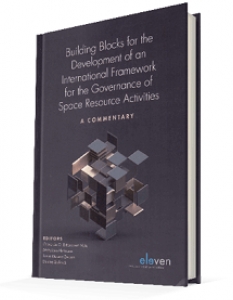Back in the 20th century, the subject of commercial space resources – at least beyond the somewhat ethereal resources of orbits and frequency-space – was largely a theoretical concept. Today, with the prospect of asteroid mining and national laws to regulate it, the exploitation of space resources is becoming more real-world.
In recognition of this, the Hague International Space Resources Governance Group was established in 2016 to lay the groundwork for the development of a framework to regulate these activities. This book provides coverage of the Group’s work in developing 20 Building Blocks that could potentially inform the eventual governance framework.
Following an introductory section, it provides a commentary on these 20 key headings, which include the principles, priority rights, registration, liability and a wealth of other legal and procedural aspects. Each commentary includes the draft text, an explanation of the text, the underlying legal basis and “alternatives discussed”. The book concludes with appendices that include the reports of the technical and socio-economic panels involved in the research.
One is reminded of the disparaging cliché about laws being like sausages (in that it is best not to see them being made), but there is something fascinating about a group of highly educated academics sitting down to discuss Space Age prospectors digging holes in asteroids, moons and comets. Clearly, the discussions extend well beyond the actual ‘spadework’, but that’s the essence of the business and it’s good to see that someone cares enough to see it done properly. Quite what ‘properly’ means is open to debate, but that’s the point of the work.
This isn’t everyone’s idea of bedtime reading, but students and practitioners of space law will find their mouths watering as they contemplate these sausages being made.











